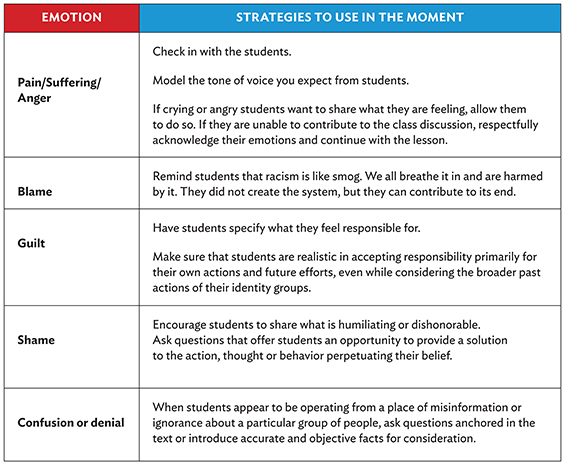In the wake of national reckonings and community trauma caused by police violence, young people need to have a role in the ongoing discussions about race, racial (in)justice and racism in the United States. This systemic violence and history affect their lives. Yet, as we documented in 2014, there is no consensus among educators about how to approach these topics. That remains true. And some educators shy away from discussions altogether. This toolkit offers a set of strategies educators can use to engage their students in meaningful and constructive discussions on race, racial (in)justice and racism.
Note: This toolkit was adapted from “Preparing to Teach The New Jim Crow.”
Essential Question
What strategies can educators use to facilitate safe and meaningful discussions on race, racial (in)justice and racism?
Procedure
1. Assess Your Comfort Level.
To strengthen your ability to facilitate conversations about race and racism, start off by assessing your own comfort level.
First, on a scale of 0-5, how comfortable are you talking about race and racism?
0 = I would rather not talk about race/racism.
1 = I am very uncomfortable talking about race/racism.
2 = I am usually uncomfortable talking about race/racism.
3 = I am sometimes uncomfortable talking about race/racism.
4 = I am usually comfortable talking about race/racism.
5 = I am very comfortable talking about race/racism.
After self-assessing and reflecting, think about how you will stay engaged in the work. Do you tend to reroute classroom discussions when you sense discomfort in the room? Commit to riding the discussion out next time. Do you feel isolated in your experiences with teaching about racial issues? Commit to identifying a colleague with whom you can co-teach, plan or debrief.
2. Address Strong Emotions.
A variety of feelings often emerge during honest conversations about race and racism, including pain, blame, anger, confusion, guilt and shame. Your role when these strong emotions arise is to remain calm and offer strategies to diffuse the situation so that learning can continue.
Spend time thinking ahead about how you will react to strong emotions when they arise. Look at the table below. Add additional emotions you think may emerge, and list potential response strategies.

3. Keep the Conversation Going.
Part of developing skills for facilitating conversations about race and racism with your students is equipping them with strategies they can use themselves. Some pedagogical approaches can help students learn to sit with their discomfort and learn to moderate that discomfort over time. Below are two approaches that Teaching Tolerance recommends:
3a. Reiterate. Contemplate. Respire. Communicate. (RCRC).
Explain these steps as a method for communicating while feeling difficult emotions. These steps are not intended to move students away from their emotions, but instead are tools to help them self-regulate.
- Step 1: Reiterate. Restate what you heard. This step will enable students to reflect upon what they have heard as opposed to what they think they may have heard. Repeating what they have heard limits miscommunication and misinformation.
- Step 2: Contemplate. Count to 10 before responding. Students can think about their responses and use the time to compose what they want to say. Taking the time to think about their responses moves students away from immediate emotional responses that can potentially derail the conversation.
- Step 3: Respire. Take a breath to check in with yourself. Suggesting students breathe before responding may help them settle their thoughts and emotional responses during difficult conversations.
- Step 4: Communicate. Speak with compassion and thoughtfulness. Students should do their best to speak to their peers as they want to be spoken to, assume good intentions and seek understanding. Explain that, when they disagree with something someone has said, they should focus on challenging the statement rather than the person who said it.
3b. Check in with students.
In order to stay on top of students' feelings of safety, risk, trust and comfort, it is important to monitor the emotional temperature in the classroom and check in with students about how they are feeling. This awareness will assist you in knowing when to stop and address strong emotions students may be experiencing.* Checking in nonverbally to gauge students’ comfort levels allows all students to participate without being singled out or put on the spot. Try some of the following ideas:
- Fist-to-Five. You can quickly gauge a number of things—readiness, mood, comprehension—by asking students to give you a “fist-to-five” signal with their hands:
- Fist: I am very uncomfortable and cannot move on.
- One finger: I am uncomfortable and need some help before I can move on.
- Two fingers: I am a little uncomfortable, but I want to try to move on.
- Three fingers: I am not sure how I’m feeling.
- Four fingers: I am comfortable enough to move on.
- Five fingers: I am ready to move on full steam ahead!
- Stoplight. Use the colors of a traffic light to indicate student readiness and comfort. Throughout the lesson, you can ask students if they are green, yellow or red. Students can also utilize the “red light” as a way to request a break or a stop when they are feeling strong emotions or have been triggered.
- Green: I am ready to proceed.
- Yellow: I can proceed but feel hesitant about moving forward.
- Red: I do not want to move on yet.
*Note: You may not be able to provide complete safety for some students—particularly students who are members of marginalized, nondominant or targeted identity groups. It is also true that an overemphasis on identity risks reducing the diverse realities of our students’ lived experiences in and outside of school.
4. Allow students time and space to debrief.
Everyone engaged in an emotionally charged conversation needs support systems in place to allow for the safe “discharge” of residual emotions. Students may have thoughts or questions that arise once they have left your classroom. Provide them with the opportunity to debrief what they are learning and their experience of learning it. Two strategies are listed below:
- Talking Circles. Gather in a circle and create, or review, the norms that will help build trust in the Circle. Select an object of significance to serve as a talking piece that signals participants to engage equally in the discussion. Whoever holds the talking piece can speak, while the rest of the Circle listens to and supports the speaker. Pose a question or statement to begin the discussion. It could be as simple as, “How do you feel about today’s lesson?” As the facilitator or Circle Keeper, you will participate as an equal member of the group. As students become familiar with the process, consider inviting them to be Circle Keepers. (Source: Amy Vatne Bintliff, “Talking Circles for Restorative Justice and Beyond.”)
- Journaling. Personal reflection through writing can be extremely effective for debriefing after difficult conversations. Journaling can help students process their emotions on their own terms and at their own pace. Journals can be kept private or can serve as a space where you dialogue with students by writing back and forth.


1 COMMENTS